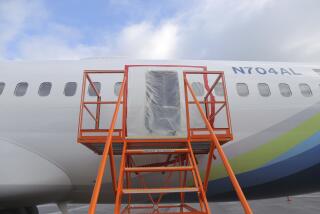Black boxes
- Share via
Airplanes usually have two black boxes: a flight-data recorder, which monitors how the aircraft is physically operating, and a cockpit voice recorder, which collects audio from the cockpit. Most black boxes record data on magnetic tape. Newer airplanes are equipped with solid-state recorders that collect information on memory chips, increasing the amount of data they can store. Despite their name, black boxes are painted bright orange and covered with strips of reflective tape to make them easy to find in a crash.
When They Are on the Plane
During flight, as many as four microphones record audio and other sounds, such as switches turned on and off, in the aircraft’s cockpit. The microphones usually are in the center of the cockpit and in the pilot, co-pilot and third crew member’s headsets.
The flight-data aquisition unit oversees the sensors. Once it has obtained information from the sensors, the acquisition unit sends the data to the recorder at the back of the aircraft, where it is stored.
Aircraft interface board: Stores data using multiple memory chips.
Audio compressor board
High-temperature insulation
This 1-inch-thick dry-silica material insulates the memory boards, protecting recorded data during fires.
Stainless-steel shell
The shell, which also can be made of titanium, contains the insulation and memory boards within its quarter-inch wall.
Underwater locater beacon
If an aircraft crashes in water, the beacon emits an ultrasonic pulse at a rate of one per second for 30 days following a crash. Search crews, using sonar-locating equipment, can find the box by following the pulses.
Stacked memory boards
Record up to two hours of audio data and 25 hours of flight information.
Memory interface cable
Connects the memory boards to the circuit board.
Testing the Boxes
Black boxes undergo several tests assessing their durability to survive airplane crashes.
Crash impact: The device is shot through an air cannon toward an aluminum target, hitting it at a force equal to 3,400 times its weight.
Fire: Placed inside a fire at 2,000 degrees Fahrenheit for one hour.
Salt-water submersion: Submerged in a tank of saltwater for 30 days.
Source: https://www.howstuffworks.com
Researched by CHRISTINE FREY / For the Times
More to Read
Sign up for Essential California
The most important California stories and recommendations in your inbox every morning.
You may occasionally receive promotional content from the Los Angeles Times.










